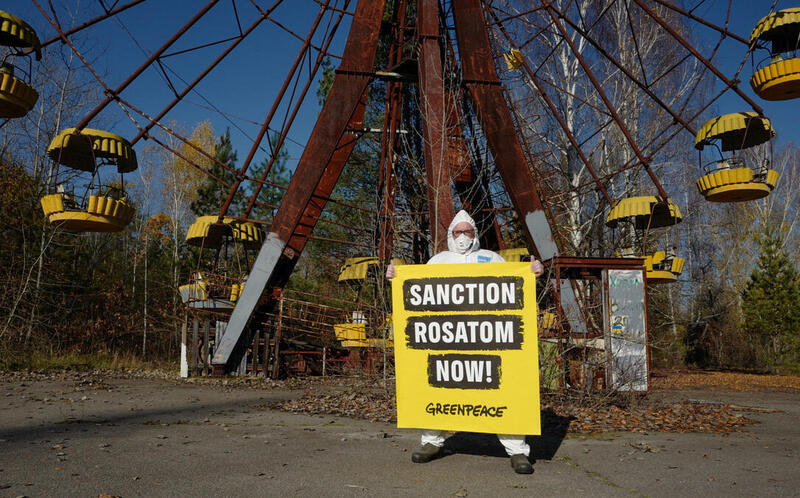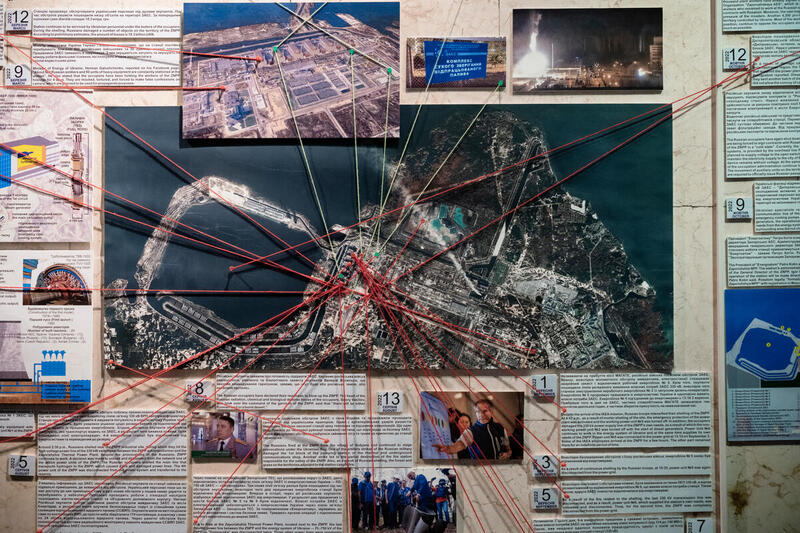Chornobyl is one of the most recognised synonyms for disaster in the world. Its legacy is a universal reminder of the horrific consequences of nuclear power when things goes wrong: on this day in 1986, a test procedure produced explosions at the power plant in Pripyat, Ukraine, causing a chain reaction that blew a colossal release of radioactive contamination across Europe and eventually much of the Northern Hemisphere.
Millions of Ukrainians have been affected by the destruction of reactor unit 4 and the radiation it released into the environment, either directly or through their families, friends and colleagues and its impact is still felt across generations.

Today, 38 years later, the spectre of nuclear catastrophe looms large – and not only in the abandoned region around Chornobyl: the ongoing illegal Russian military occupation of the south-eastern Zaporizhzhia nuclear power plant, the largest in Europe and one of the 10 biggest in the world, installed by force the Russian state nuclear authority Rosatom. In doing so, Moscow placed in danger not only Ukraine, but most of Europe – and with chilling echoes of a Soviet era mentality that prioritised domination over life and safety and produced the catastrophe in Chornobyl.
Chornobyl's RBMK reactor design had evolved out of the Soviet Union's 1950s military reactors used for producing plutonium for nuclear weapons, and were known even then to be unsafe. Scientists warning of integral instabilities, including a 'positive steam coefficient' which could lead to an explosion, were ignored. Twenty years later, that design flaw and others led to two massive explosions that destroyed the Chornobyl unit 4 reactor and shook the world.
In the years between 1986-1990, over 600,000 firefighters, soldiers, janitors, and miners – collectively known as 'liquidators' – were sent to the Chornobyl site after the explosion in an attempt to respond to the disaster. Many tens of thousands have suffered long term health consequences and death.
The ramifications were significant also to Moscow: Mikhail Gorbachev, who oversaw the dissolution of the USSR, even theorised that Chornobyl was key in its collapse.
For the decades that followed, hundreds of Ukrainian scientists, engineers and technicians worked daily to monitor, evaluate and seek to recover control of the Chornobyl nuclear site and vast radioactive exclusion zone – until, that is, the Russian invasion of February 2022.
The Russian threat at Zaporizhzhia nuclear power plant
By sidelining Zaporizhzhia's Ukrainian engineers at gunpoint, and by deliberately firing missiles at Ukraine's wider energy infrastructure, the Kremlin risks repeating terrible lessons from history. The Russian invasion presence places Ukraine's four nuclear power plants - South Ukraine, Rivne, Khemelnitsky and especially Zaporizhzhia – at risk of an emergency power loss and station blackout.

Despite heroic efforts by Zaporizhzhia workers and citizens of nearby Energodar to barricade the main access road with vehicles, tyres and sandbags to block the advancing Russian troops, they were overwhelmed and the resulting assault damaged the plant, including its vital electricity infrastructure for maintaining the cooling function of the hot nuclear fuel. One reactor core producing heat for the electricity has the power of two million water cookers: if cooling stopped after shutdown, it would take only hours for the cooling water to boil off, expose the hot nuclear fuel to the air and melt down, leading to a new major nuclear disaster. In peacetime, power plant workers still have several options to restore cooling in an emergency, but in a war zone this is severely and constantly compromised.
There is a long list of dangerous incidents caused by the Russian invasion, including the destruction of the Nova Kakhovka dam on 6 June 2023, which not only led to an enormous damage and suffering below the dam, but also emptied the Kakhovka reservoir providing cooling water for the Zaporizhzhia nuclear plant.
Nuclear history repeating itself?
The ultimate blow to nuclear safety however is the plan of Rosatom and Moscow to attempt to restart one or more reactors at the Zaporizhzhia nuclear plant. The existing cooling water resources are far from sufficient to cool an operational reactor. Rosatom would have to build a new pump system, which would not be as reliable, and it does not have the workforce and expertise to control an operational reactor, especially in a warzone. Nuclear energy is incompatible with a world marred by conflict and instability.
Russia might have launched a disinformation campaign to pave the way for blaming Ukraine in case something goes very wrong. Hiding behind false flag attacks might make it easier for them to take higher risks. That is why it is so important to remember Chornobyl today, and how it happened, through irresponsible deliberate decisions and acts by the Soviet system.
Greenpeace Germany has written to Rafael Mariano Grossi, the International Atomic Energy Agency (IAEA) Director General calling on him to make clear to Rosatom and the Russian government that restart of Zaporizhzhia under Russian control is unconscionable. The IAEA must do all it can to prevent restart and not cooperate with Rosatom, nor seek to accommodate the interests of the nuclear industry, or it risks repeating the grave mistakes of the past.
Shaun Burnie and Jan Vande Putte are nuclear campaigners for Greenpeace Germany and Greenpeace Belgium
Daryna Rogachuk is communications officer for the Green Reconstruction of Ukraine project www.greenreconstruction.com






